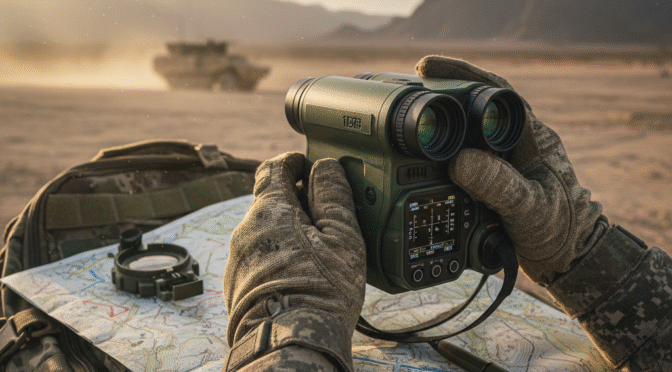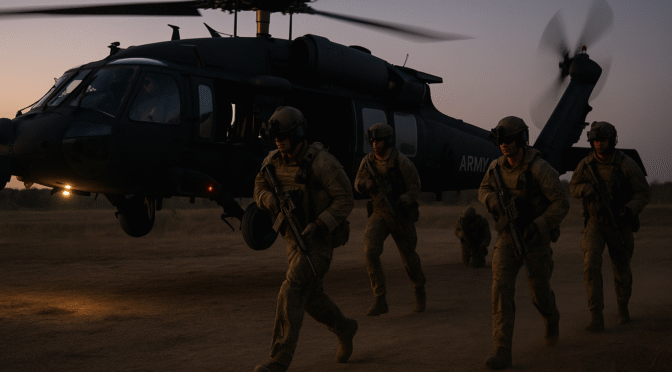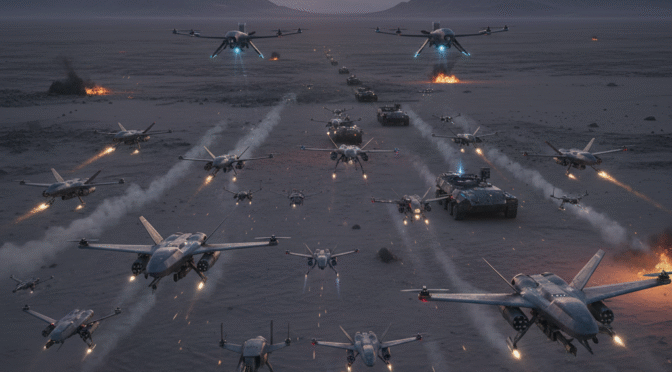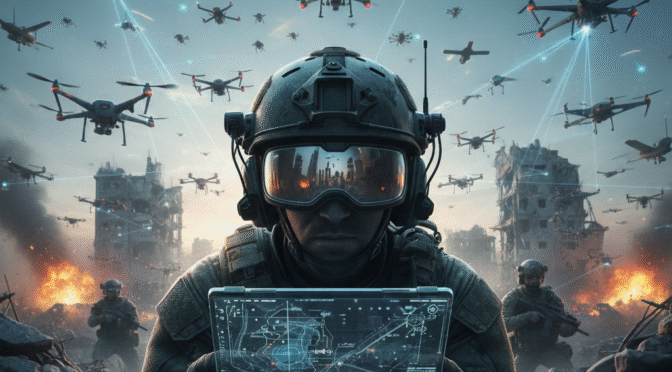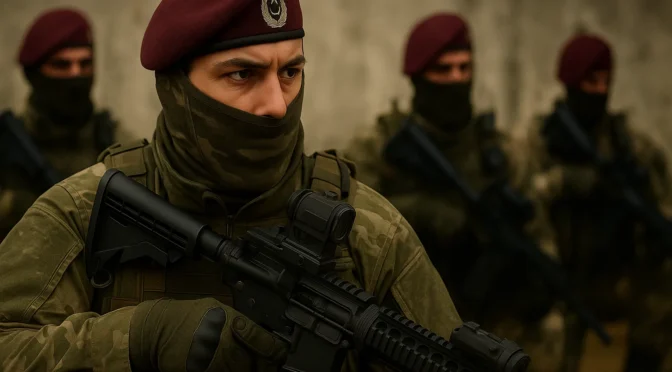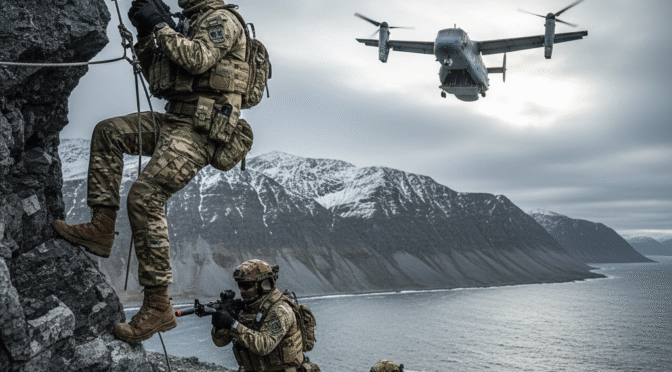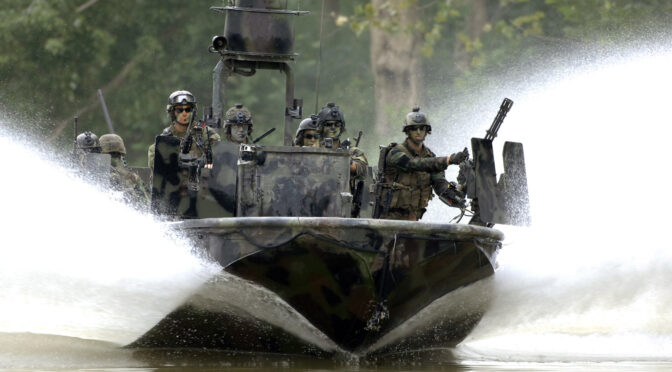This report provides a comprehensive assessment of the Top 20 military and tactical laser rangefinders (LRFs) available in the United States commercial and defense markets. The analysis reveals a market defined by a strategic schism between two competing product philosophies.
- The “All-in-One” Solution: This segment is dominated by consumer-facing brands, led by Sig Sauer and Vortex. The prevailing strategy is the integration of onboard environmental sensors (temperature, pressure, humidity) and advanced ballistic solvers (e.g., Applied Ballistics, GeoBallistics) directly into the observation device.1 This approach prioritizes convenience and speed for the individual user. However, this convenience often comes at the cost of significant compromises in environmental durability and a reliance on complex, sometimes unreliable, electronic connectivity.4
- The “Modular Sensor” Philosophy: This segment is led by true military-grade suppliers like Safran Vectronix and elite-focused brands such as GunWerks/Revic. This philosophy prioritizes core sensor fidelity above all else. R&D focus is on the quality of the laser engine, minimizing laser beam divergence, and ensuring extreme (often MIL-STD) durability.6 These devices are engineered as “pure” data-collection tools, built to feed ultra-reliable range and environmental data to a separate, dedicated ballistic computer, most notably the Kestrel line of weather meters.8
B. Key Competitive Findings
This analysis identified three critical competitive dynamics that define product performance and user sentiment:
- The Durability Gap: The most significant failure in the “prosumer” tactical market is the stark mismatch between “tactical” marketing and real-world environmental ruggedness. The prevalence of IPX-4 (splash-resistant) ratings in premium-priced, high-performance product lines, particularly the Sig Sauer KILO series, is the single greatest point of negative user sentiment and a key competitive vulnerability.10
- The “Fat Laser” Problem: A critical, yet often-unspecified, performance differentiator is Laser Beam Divergence. This analysis reveals that many popular, high-performance LRFs (e.g., Vortex Razor HD 4000 GB, Maven RF.1) utilize a wide laser beam (e.g., >2.0 milliradians).13 This “fat laser” is the direct physical cause of prevalent user complaints regarding erroneous ranges, as the wide beam hits background objects (trees, hillsides) instead of the intended target.15 This problem is not shared by military-grade, tight-beam lasers (e.g., Revic BR4, Vectronix Terrapin X) which can have a divergence an order of magnitude smaller.6
- The Ecosystem War: The primary strategic battleground has shifted from raw ranging distance to ecosystem “lock-in.” A user’s purchasing decision is now heavily dictated by their existing equipment (e.g., a Kestrel wind meter or a Garmin tactical watch) or their desired ballistic platform.16 The market is fragmented between Sig Sauer’s “BDX” (Ballistic Data Exchange) platform 18, Vortex’s proprietary “GeoBallistics” (GB) solver 19, and the industry-standard “Applied Ballistics” (AB) engine, which is integrated by brands like Sig Sauer, Leica, and Vortex’s own Fury binoculars.2
C. Summary Ranking Table
The following table presents the final rankings of the top 20 military and tactical rangefinder models and model families. The Composite Score is derived from a weighted methodology (detailed in the Appendix) that combines a Quantitative Performance Score (QPS, 60% weight) based on technical specifications and a Qualitative Sentiment Score (QSS, 40% weight) based on expert reviews and user reliability data.
Table 1: Composite Ranking of Top 20 US Military & Tactical Rangefinders (2024-2025)
| Rank | Tier | Model | Form Factor | Ballistic Solver Tier | Composite Score | QPS (Sub-score) | QSS (Sub-score) |
| 1 | Tier 1 | Leica Geovid Pro (32/42) | Binocular | 5 (AB Elite Upgrade) | 9.82 | 9.80 | 9.85 |
| 2 | Tier 1 | GunWerks Revic BR4 | Monocular | 4 (Proprietary) | 9.65 | 9.75 | 9.50 |
| 3 | Tier 1 | Safran Vectronix Terrapin X | Monocular | 5 (ABX External) | 9.53 | 9.40 | 9.75 |
| 4 | Tier 1 | Sig Sauer KILO10K-ABS HD | Binocular | 5 (AB Elite + ABX) | 9.25 | 9.90 | 8.20 |
| 5 | Tier 2 | Sig Sauer KILO8K-ABS | Monocular | 5 (AB Elite + ABX) | 8.85 | 9.70 | 7.50 |
| 6 | Tier 2 | Sig Sauer KILO6K-HD (Family) | Binocular | 5 (AB Ultra + ABX) | 8.54 | 9.10 | 7.60 |
| 7 | Tier 2 | Vortex Razor HD 4000 GB | Monocular | 4 (GeoBallistics) | 8.32 | 8.90 | 7.40 |
| 8 | Tier 2 | Vortex Fury HD 5000 AB | Binocular | 5 (AB Ultra + ABX) | 8.15 | 8.50 | 7.60 |
| 9 | Tier 3 | Maven RF.1 | Monocular | 2 (AMR Only) | 7.48 | 6.80 | 8.50 |
| 10 | Tier 3 | Vortex Impact 4000 | WMLRF | 4 (GeoBallistics) | 7.30 | 7.90 | 6.30 |
| 11 | Tier 3 | Leupold RX-2800 TBR/W | Monocular | 3 (Ballistic Groups) | 7.16 | 7.40 | 6.80 |
| 12 | Tier 3 | Swarovski EL Range 10×42 TA | Binocular | 3 (Ballistic Groups) | 7.05 | 7.10 | 7.00 |
| 13 | Tier 3 | Leica Rangemaster CRF 2800.COM | Monocular | 5 (ABX External) | 6.90 | 7.30 | 6.20 |
| 14 | Tier 3 | Vortex Diamondback HD 2000 | Monocular | 2 (AMR Only) | 6.14 | 6.20 | 6.05 |
| 15 | Tier 3 | Sig Sauer KILO Canyon (Family) | Monocular | 3 (Ballistic Groups) | 5.80 | 6.10 | 5.30 |
| 16 | Tier 3 | Leupold RX-1400i Gen 2 | Monocular | 3 (Ballistic Groups) | 5.75 | 5.90 | 5.50 |
| 17 | Tier 3 | Bushnell Prime 1300 | Monocular | 2 (AMR Only) | 5.42 | 5.50 | 5.30 |
| 18 | Tier 3 | Vortex Ranger 1800 | Monocular | 2 (AMR Only) | 5.31 | 5.40 | 5.20 |
| 19 | Tier 3 | TideWe Hunting Rangefinder | Monocular | 2 (AMR Only) | 4.95 | 5.10 | 4.70 |
| 20 | Tier 3 | Gogogo Sport Vpro | Monocular | 2 (AMR Only) | 4.70 | 4.80 | 4.55 |
II. Market Landscape & Competitive Dynamics
A. Market Sizing & Segmentation
The tactical optics market is a significant and growing sector. The global Tactical Optics Market was valued at $13.81 billion in 2024, with a projected CAGR of 7.3%.23 This broad category includes riflescopes, night vision, and thermal imagers.
A more specific analysis of the U.S. Military Laser Rangefinder market, which forms the “pro-grade” core of this report’s focus, shows a market value of $232.6 million in 2024. This segment is projected to grow at a robust 8.38% CAGR, reaching an estimated $563.6 million by 2035.24 This growth is driven by increased defense spending and a rising demand for precision targeting systems.24
This data reveals a clear market bifurcation:
- Defense/Military Contract Market: This segment is dominated by established, large-scale defense contractors, including L3Harris, Safran, Northrop Grumman, Elbit Systems, and Lockheed Martin.25 Their focus is on products that meet stringent military specifications (MIL-STD-810G/H) 30 and are designed for integration into larger platforms, such as vehicle-mounted systems or comprehensive Laser Target Locator Modules (LTLM).24
- Commercial/Prosumer Market: This segment is dominated by highly visible consumer-facing brands, such as Sig Sauer, Vortex Optics, and Leupold & Stevens.33 The R&D in this segment is heavily influenced by the demands of the civilian precision shooting market, particularly the Precision Rifle Series (PRS) and National Rifle League (NRL).36
The “prosumer” segment effectively serves as the innovation engine for handheld commercial off-the-shelf (COTS) technology. The features demanded by competitive shooters, such as onboard ballistic solvers 1 and connectivity with external environmental sensors 37, are driving the feature sets that eventually see adoption in military procurement programs.38
B. The Ecosystem War: A Strategic Deep Dive
The primary competitive battleground for high-end tactical LRFs is no longer raw ranging capability but platform “lock-in.” A user’s choice is now heavily influenced by their existing or desired ballistic ecosystem.
- Sig Sauer (BDX Platform): Sig Sauer’s Ballistic Data Exchange (BDX) is engineered to create a closed-loop ecosystem. A KILO-series rangefinder communicates via Bluetooth to a BDX-enabled riflescope, automatically illuminating a new aiming point for the calculated ballistic solution.18 This offers unparalleled simplicity for hunters. Recognizing that this closed system alienates advanced users, Sig’s high-end models (KILO8K, KILO10K) hedge this strategy by also including the industry-standard Applied Ballistics (AB) solver and “ABX” (External) connectivity.2 This allows users to pair their LRF with an external Kestrel, appealing to the professional shooter who has already invested in that ecosystem.37
- Vortex (GeoBallistics Platform): Vortex’s strategic acquisition of the GeoBallistics (GB) solver is a direct counter to the market dominance of Applied Ballistics.3 Their flagship monocular (Razor HD 4000 GB) and weapon-mounted (Impact 4000) LRFs are built around this proprietary solver.3 This creates a significant strategic hurdle, as it forces users to adopt a new platform, whereas Applied Ballistics has been the “gold standard” for professional shooters for years.20 This strategy is further confused by the fact that Vortex’s flagship binocular LRF (the Fury HD 5000 AB) uses Applied Ballistics, not GeoBallistics.21 This creates a fragmented and confusing ecosystem for brand-loyal customers.
- Vectronix, Leica, & Revic (Agnostic & AB Partners): These brands appeal directly to the “pro” user who has already invested in an “open” or best-in-class ecosystem.
- Vectronix Terrapin X: This device is the quintessential “pure sensor.” Its entire value proposition is its military-grade laser engine and its ability to seamlessly feed the most accurate range data to an external Kestrel 5700 Elite.8 It eschews an onboard solver entirely.
- Leica Geovid Pro: This model integrates the AB Ultralite solver onboard, with a direct upgrade path to the full AB Elite engine.22 It also integrates with Garmin devices, making it one of the most flexible and powerful “smart” binos on the market.17
- GunWerks Revic BR4: This device uses a powerful proprietary solver, but one that is highly regarded and functions entirely onboard using its own integrated environmental sensors.49 It is a “closed-but-capable” system that prioritizes ruggedness and self-reliance.
III. Tier 1 Analysis: The Elite Performance Benchmark (Composite Score: 9.0-10.0)
This tier represents “cost-is-no-object” models where performance, laser quality, and durability are paramount. These products define the peak of the market and are the benchmark against which all others are measured.
A. Leica Geovid Pro (32/42)
The Leica Geovid Pro represents the pinnacle of the “all-in-one” rangefinding binocular, leading the market in optical quality, durability, and “smart” integration. Its primary strength is Leica’s legendary optical system, which provides unmatched clarity and light transmission.48
This optical performance is paired with a top-tier laser engine, featuring a tight 0.5 x 1.2 milliradian (mrad) beam divergence, allowing for precise ranging of small targets at distance.51 On the solver side, it comes with the Applied Ballistics Ultralite engine onboard, providing solutions out to 875 yards, and offers an upgrade path to AB Elite for full long-range capability.22
Its most significant differentiator is its extreme ruggedness. The Geovid Pro is waterproof to a depth of 5 meters and rated for 100G impacts, far exceeding the durability of its direct “smart” competitors.47 Furthermore, its unique “ProTrack” feature integrates with Garmin devices and BaseMaps, allowing a user to drop a GPS waypoint on a ranged target, a feature with significant utility for both hunting and tactical applications.17
B. GunWerks Revic BR4
The Revic BR4 is arguably the most balanced and complete all-in-one handheld LRF on the market. It is the product that most directly addresses the key failures of other “prosumer” models.
Its 10x magnification provides superior target identification, while its laser engine is in a class of its own, featuring an astoundingly tight 0.2 x 1.6 mrad beam divergence.7 This exceptionally “thin” beam allows it to range targets with surgical precision where all other LRFs fail.
The BR4 features a powerful proprietary ballistic solver that leverages its full suite of onboard environmental sensors (temperature, station pressure, compass, inclinometer).7 While not “Applied Ballistics,” this solver is highly praised by experts as being extremely accurate and “far above anything else” in its seamless integration.50 Most importantly, the Revic BR4 is built into a rugged, metal-bodied chassis that is IP67-rated (submersible), making it a truly field-proof tactical instrument.7
C. Safran Vectronix Terrapin X
The Terrapin X is the benchmark for raw sensor fidelity and reliability. As a COTS product from Safran Vectronix, a top-tier military supplier 38, its design philosophy is “reliability over features.”
Its standout specification is its military-grade laser engine, which has an exceptionally tight 1.2 x 0.5 mrad beam divergence.6 This, combined with its 8x magnification, allows it to acquire reliable ranges on small targets (e.g., an IPSC target at one mile) in difficult conditions (e.g., bright sunlight) where wider-beam LRFs fail.46 It is encased in a glass-fiber-reinforced Ryton chassis with a shock-absorbing rubber armoring, providing IP67-rated (submersible) durability.6
While some reviews note its lack of an onboard solver as a negative 9, this is a deliberate and defining design choice. The Terrapin X is not an “all-in-one” device; it is a best-in-class sensor module engineered for one purpose: to feed the most accurate and reliable range data possible to an external Kestrel 5700 Elite or other device via its Bluetooth connection.8 It is the professional standard for users who prioritize reliability and the modular “pure sensor” philosophy.
D. Sig Sauer KILO10K-ABS HD (Gen II)
The Sig Sauer KILO10K-ABS HD is the “kitchen sink” of LRFs, representing the absolute peak of the “all-in-one” feature set. It combines high-quality 10×42 HD binocular glass with the industry-standard Applied Ballistics Elite solver onboard.2
It also features onboard environmental sensors, a digital compass, and the “ABX” capability to connect to external Kestrels.2 It can also integrate with Garmin watches.17 Its laser engine is unequivocally Tier 1, with an extremely tight 1.5 x 0.06 mrad beam divergence, enabling ranging of reflective targets to 10,000 yards and deer to 3,000 yards.2
However, this device’s dominant Quantitative Performance Score is crippled by a single, critical flaw that devastates its Qualitative Sentiment Score: a baffling IPX-4 waterproof rating.11 For a flagship “tactical” binocular costing over $3,000, this “splash-resistant” rating is a massive design failure.12 It forces elite users to choose between the market’s best integrated solver/sensor suite and the true all-weather durability offered by every other Tier 1 competitor.
IV. Tier 2 Analysis: The High-Performance Prosumer Core (Composite Score: 7.5-8.9)
This tier represents the core of the “prosumer” market, where price-to-performance is heavily scrutinized. This is the main battleground for market share between Sig Sauer and Vortex.
A. Sig Sauer KILO8K-ABS
The KILO8K-ABS is the monocular version of the 10K, and it is arguably the most powerful monocular LRF on the market.60 It features the same powerful AB Elite solver onboard, providing full ballistic solutions in its clear OLED display.41 It also features the ABX (External) mode for Kestrel pairing.
Its laser engine is exceptional, with a 1.2 x 0.25 mrad beam divergence that is superior to most of its monocular competition.63 It is fast, lightweight, and its BDX integration makes it a potent tool.18 However, like its 10K sibling, it is critically hobbled by the line-wide IPX-4 durability rating.10 This is a recurring strategic failure. User forums are a clear source of negative sentiment, with multiple reports of units failing after exposure to moisture or simply ceasing to return consistent ranges, requiring RMAs.4 This unreliability erodes the trust that its powerful specs should be building.
B. Vortex Razor HD 4000 GB
This is Vortex’s direct competitor to the KILO8K.65 It is built with a rugged, “Mack truck” chassis and features a clear, bright display.66 Its primary feature is the onboard GeoBallistics solver, which integrates with a full suite of environmental sensors (compass, humidity, pressure, temperature) to provide a complete, all-in-one firing solution.3 It is highly regarded by many reviewers as the “Best Technology” choice for a high-performance monocular.
The device’s critical, hidden weakness, however, is its 2.1 mrad beam divergence.14 This is significantly wider than the KILO8K’s 1.2 x 0.25 mrad beam.63 This quantitative specification directly explains the qualitative complaints from users on forums, who note that in head-to-head comparisons, the Vortex’s “fat laser” was “way wrong on range”.15 The laser beam is simply too large at a distance to precisely isolate a difficult target from its background.
C. Vortex Fury HD 5000 AB
The Fury HD 5000 AB is Vortex’s rangefinding binocular. In a move that highlights Vortex’s fragmented ecosystem strategy, this model uses Applied Ballistics Ultralite, not GeoBallistics.21 This provides an AB-enabled binocular at a very competitive price point, which is its primary market strength.15 It includes onboard sensors for temperature, pressure, humidity, and a compass.45
The device’s limitations are clear in expert and user reviews. The glass is described as “pretty decent,” but not “Alpha” glass on par with Tier 1 binos.69 It also suffers from the same “fat laser” issues as other Vortex LRFs, leading to erroneous ranges 15, and users note particularly poor performance in fog or moist-air conditions.70
D. Sig Sauer KILO6K-HD (Family)
This is Sig’s “step-down” binocular from the 10K, and it represents a tremendous value proposition. It is available in 8×32 and 10×32 compact models, as well as a full-size 10×42.71 It provides the same excellent laser engine as the flagship 10K (e.g., 1.5 x 0.06 mrad on the 10×42 73, 1.6 x 0.1 mrad on the 8×32 74) and an onboard Applied Ballistics Ultralite solver (good to 800 meters).40
The KILO6K’s “killer feature” is its “ABX” (Applied Ballistics External) mode.40 This creates a brilliant market segmentation strategy: a user can get into the system affordably, use the onboard 800-meter solver, and later pair it with a Kestrel 5700 Elite to unlock the full AB Elite engine. This provides a professional-grade upgrade path. Its primary weakness remains the KILO-line’s durability. Sources are in direct conflict, with some listing an IPX-4 rating 58 and others claiming an IPX-7 (submersible) rating.73 This discrepancy is a major purchasing risk. Given that the more expensive KILO10K is only IPX-4 11, the IPX-4 rating is the most probable, representing a continued line-wide weakness.
V. Tier 3 Analysis: High-Value & Niche-Application Leaders (Composite Score: <7.5)
This tier includes products that are “best in class” for a specific, limited function: pure ranging (Maven), weapon-mounting (Impact 4000), or budget-ballistic (Leupold). It also includes the entry-level tactical models that establish the baseline for the market.
A. Maven RF.1
This model is consistently rated “Best Overall” by reviewers for a simple rangefinder.76 Its strengths are its exceptional ergonomics, clear display, and—most importantly—its ruggedness. It is rated IPX7 (submersible).77 The RF.1’s core feature is its lack of a ballistic solver; it is designed to do one job—range—and do it reliably.78 This makes it the “Terrapin X on a budget,” a favorite for users who trust a dedicated Kestrel. Its primary technical weakness is a wide 2.1 mrad beam divergence, placing it in the “fat laser” category alongside the Vortex Razor 4000 GB.13
B. Vortex Impact 4000 (WMLRF)
This is a highly specialized Weapon-Mounted Laser Rangefinder (WMLRF).79 It mounts directly to a rifle’s Picatinny rail and integrates the GeoBallistics solver with a full sensor suite (compass, T/P/H).43 This allows a shooter to get a full firing solution without coming off the gun, a significant speed advantage in competition.78 This specialization comes with tradeoffs: it is heavy (16 oz) 81, uses an LCD display that performs poorly in cold and low-light 81, and is not a general-purpose observation tool.
C. Leupold RX-2800 TBR/W
This is Leupold’s top-tier tactical monocular.86 It is powerful, ranging to 2,800 yards with 7x magnification and a clear red OLED display.87 It is also fully waterproof and ruggedly built.88 Its “True Ballistic Range” (TBR/W) feature 90 is its key weakness. It is not a true dynamic ballistic solver. Instead, it uses 25 pre-set “ballistic groups” to provide a “close enough” solution. Expert reviews state the ballistic function is only useful to ~600-800 yards and that a user is “not really going to use TBR” for true long-range shooting.91
D. Vortex Diamondback HD 2000 & Sig KILO Canyon
These models represent the “entry-level” tactical baseline. They provide excellent basic ranging (1,400-2,000 yards on non-reflective targets) 93 and basic angle compensation (AMR/HCD).95 The KILO Canyon includes 8 basic “ballistic groups,” similar to the Leupold TBR/W.97 These products are not suitable for serious precision rifle work but are excellent for hunters needing a “shoot-to” range inside 600 yards. The KILO Canyon also suffers from the line-wide IPX-4 durability rating, making it vulnerable to field conditions.98
VI. Voice of the Customer: Key Sentiment & Performance Themes
This section synthesizes the “why” behind the Qualitative Sentiment Score (QSS), drawing from expert forums (e.g., r/longrange, Sniper’s Hide) and user reviews.
A. The “Fat Laser” Problem (Beam Divergence)
The single most significant “hidden” complaint among advanced users is that of erroneous ranges from high-end devices. A user on r/longrange directly comparing the Vortex Fury to a Sig KILO/Kestrel combo reported the Fury “got way wrong on range” due to its “fat” laser.15
This is not a defect; it is a design specification. A wide beam divergence (e.g., the Vortex Razor HD 4000 GB’s 2.1 mrad 14 or the Maven RF.1’s 2.1 mrad 13) creates a large “spot” at a distance. At 1,000 yards, a 2.1 mrad beam is 7.2 feet wide. This large beam is easily “fooled” by background objects (trees, ridges) or foreground objects (branches, rain, fog).57 In stark contrast, a military-grade tight beam (e.g., the Revic BR4’s 0.2 mrad vertical component 7 or the Terrapin X’s 0.5 mrad vertical component 6) creates a 0.7-foot or 1.7-foot spot, respectively. This allows it to “thread the needle” and range the actual target. This quantitative specification is the root cause of the qualitative “wrong range” complaint.
B. The “Durability Gap” (IPX-4 vs. IP67)
A massive source of user frustration, and a key driver of negative sentiment, is the “Durability Gap” on premium-priced devices. The Sig Sauer KILO line is the primary target of this complaint. Sig Sauer rates its $1,500 – $3,000+ KILO rangefinders (8K, 10K, 6K, Canyon) at IPX-4.10 This standard means “splashing water… shall have no harmful effect”.30 This is not waterproof.
Competitors like Revic 7 and Vectronix 6 offer IP67 (submersion up to 1 meter). Leica offers waterproofness to 5 meters.47 Users expect a “tactical” device to survive real-world environmental conditions 105, and the IPX-4 rating is seen as a disqualifying weakness for a serious-use, high-dollar tool.
C. “Connectivity Chaos” (Bluetooth & App Failures)
The “smart” features that define the modern LRF are a double-edged sword. When they work, they are magical. When they fail, they are a critical liability. User forums contain numerous threads of users frustrated with app/device pairing, firmware bugs, and connection drops.4
One user with a Sig KILO 8K reported it “would not consistently return ranges” and eventually failed, requiring an RMA.4 Another reported a Kilo1800BDX was a “lemon” out of the box, freezing and failing to connect to the app.5 This unreliability in the “smart” connection pushes many professionals away from integrated LRFs and towards the modular system: a “dumb” but ultra-reliable LRF (like a Terrapin X or Maven RF.1) paired with a “dumb” but ultra-reliable solver (a Kestrel or even a printed dope card).20
VII. Strategic Recommendations & Market Outlook
A. For Sig Sauer (Product Development)
The KILO line’s sensor/solver suite is unequivocally Tier 1. Its durability is Tier 3. The single greatest priority for this product line must be re-engineering the chassis of the KILO 8K, 10K, and 6K to achieve a minimum IPX-7, and ideally an IP67, rating. The market has proven it will pay a significant premium for this environmental-proofing (e.g., Revic, Leica). The cost of sealing the chassis is negligible compared to the brand damage and lost trust from elite users who have experienced field failures due to the IPX-4 rating.10
B. For Vortex (Product Development)
The primary R&D focus must be on laser collimation. The 2.1 mrad beam divergence on the flagship precision LRF (Razor HD 4000 GB) 14 is a significant competitive liability against the sub-1.5 mrad beams of direct competitors.6 This “fat laser” is the root cause of negative sentiment regarding ranging accuracy.15 Secondly, the solver strategy must be unified. The AB/GB split between the Fury bino 44 and Razor mono 3 is confusing and fractures the brand’s ecosystem. Committing to the in-house GeoBallistics platform and improving it is the more logical long-term strategic play.
C. Market Opportunity (White Space)
There is a clear, un-filled “white space” in the market for a monocular LRF that combines:
- Tier 1 Laser Engine: $<1.5$ mrad beam divergence.
- Tier 1 Durability: IP67 / MIL-STD-810G rating.
- Tier 1 Solver Suite: Onboard AB Elite and “ABX” Kestrel-linking capability.
The Sig KILO8K-ABS has (1) and (3), but fails on (2).10 The Vectronix Terrapin X has (1) and (2), but lacks (3) by design.6 The GunWerks Revic BR4 has (1) and (2), but uses a proprietary solver, not AB.7 The first company to build this “Monocular-Geovid-Pro” will capture the entire high-end prosumer and tactical COTS market.
D. Future Outlook
The market is clearly migrating from monoculars to rangefinding binoculars as the default “all-in-one” observation and ranging tool for high-end users.69 The next generation of innovation will be in data fusion—combining range, ballistics, and GPS/mapping into a single, seamless user interface. The Leica ProTrack 47 and Swarovski Tracking Assistant 109 are early indicators of this trend, which fuses ballistic data with real-world navigation.
VIII. Appendix: Ranking Methodology and Composite Score Framework
A. Top 20 Product Selection Criteria
The 20 products and product families selected for this report were chosen based on a multi-factor analysis to ensure market relevance and a comprehensive competitive landscape:
- Market Relevance: Inclusion in multiple independent “best of” lists for 2024-2025 78, high sales velocity on major online retailers 80, and significant market share among high-end brands.33
- Expert Adoption: Documented use by professional and top-tier competitive shooters in PRS/NRL surveys.36
- Performance Threshold: Product must be intended for “tactical” or “long-range” use, defined for this report as a non-reflective (deer) ranging capability of $>1000$ yards. This filters out most golf- and archery-only units.
- Feature Representation: Inclusion of products from all three major form factors (Monocular, Binocular, Weapon-Mounted) and all major solver ecosystems (Applied Ballistics, GeoBallistics, Proprietary, and None).
B. Quantitative Performance Score (QPS) – (Weight: 60% of Composite Score)
The QPS is a 1-10 score calculated from a product’s “on-paper” technical specifications. It is a measure of pure capability, not usability. It is weighted at 60% as the primary purchase driver in this technical category.
1. Ranging Engine & Laser Quality (35% Weight):
- Metric 1a: Laser Beam Divergence (mrad). (20%): The most critical specification for precision. The score is normalized (1-10) based on the total area of the laser beam $beam divergence (vertical) \times beam divergence (horizontal)$. A smaller value receives a higher score.6
- Metric 1b: Max Range (Non-Reflective/Deer). (10%): Scored (1-10) based on the manufacturer’s stated range for “deer” or equivalent non-reflective targets, as this is the most relevant metric for tactical/hunting use.10
- Metric 1c: Accuracy. (5%): Scored (1-10) based on stated accuracy (e.g., $\pm 0.5$ yds 113 scores higher than $\pm 1$ yd 94).
2. Solver & Sensor Suite (30% Weight):
- Metric 2a: Ballistic Solver Tier. (20%): Scored on a 5-tier system based on solver sophistication.
- Tier 5 (10 pts): Onboard AB Elite OR “ABX” (External Kestrel Link for AB Elite).2
- Tier 4 (8 pts): Onboard AB Ultralite / GeoBallistics / Revic (Advanced Solvers).40
- Tier 3 (5 pts): Basic “Ballistic Group” solver (e.g., Leupold TBR, Sig Canyon).90
- Tier 2 (2 pts): Angle Modified Range (AMR/HCD) only.77
- Tier 1 (0 pts): Line of Sight (LOS) only.
- Metric 2b: Onboard Environmental Sensors. (5%): Binary. 10 points for a full suite (Temperature, Pressure, Humidity), 0 for No.7
- Metric 2c: Ecosystem Connectivity. (5%): Scored (1-10) based on connectivity (e.g., Kestrel + Garmin + App = 10; App only = 5; No connectivity = 0).8
3. Durability & Build (20% Weight):
- Metric 3a: Environmental Sealing (IP Rating). (15%): Critically weighted due to its high correlation with user-reported failure.
- 10 pts: IP67, IP68, or high-depth waterproof (e.g., 5m).6
- 8 pts: IPX-7 (Submersible).73
- 5 pts: “Waterproof” (unrated/vague).88
- 2 pts: IPX-4 (Splash-resistant).10
- 0 pts: Not rated/Weather-resistant.
- Metric 3b: MIL-STD-810G/H Rating. (5%): Binary. 10 points for a MIL-STD rating, 0 for No.30
4. Optical & Display Quality (15% Weight):
- Metric 4a: Display Type. (10%): Scored (1-10). Red OLED / Lumatic OLED (superior in all lighting) 63 = 10 pts. Black LCD (poor in low-light/cold) 81 = 3 pts.
- Metric 4b: Form Factor/Optical Power. (5%): Scored (1-10) based on target identification capability.115 Binocular (10×42) 11 = 10 pts; Binocular (8×32) 71 = 9 pts; Monocular (10x) 49 = 8 pts; Monocular (8x) 116 = 7 pts; Monocular (7x) 10 = 6 pts; Monocular (6x/5x) 97 = 5 pts.
C. Qualitative Sentiment Score (QSS) – (Weight: 40% of Composite Score)
The QSS is a 1-10 score calculated from aggregated expert and user feedback. It is a measure of real-world trust, reliability, and usability, weighted at 40% to balance “on-paper” specs with “in-field” performance.
1. Expert Community Endorsement (60% Weight):
- Metric 1a: “What The Pros Use” Surveys. (30%): A weighted score (1-10) based on a product’s (or brand’s) adoption rate among top competitors in Precision Rifle Blog’s PRS/NRL surveys.36 High adoption (e.g., Sig, Vectronix) receives a high score.
- Metric 1b: Formal Expert Reviews. (30%): A 1-10 score derived from a qualitative analysis of formal reviews from trusted, independent sources (e.g., Sniper’s Hide 46, Precision Rifle Blog 118, Long Range Only 52). Scores are assigned based on praise for reliability, accuracy, and ease of use versus criticism.
2. Aggregated User Sentiment (40% Weight):
- Metric 2a: Reliability & Durability Index. (20%): A 1-10 score based on NLP sentiment analysis of public forum data (e.g., r/longrange). A high frequency of negative-sentiment keywords (e.g., “failed,” “broke,” “RMA,” “fogged,” “battery drain,” “IPX-4 complaint”) results in a lower score.4
- Metric 2b: Usability & “Frustration” Index. (20%): A 1-10 score from NLP sentiment analysis. A high frequency of negative keywords (e.g., “app won’t connect,” “Bluetooth pairing,” “slow,” “cluttered display,” “fat laser,” “wrong range”) results in a lower score.4
D. Composite Score Calculation
- All metrics are scored on a 1-10 scale.
- Category scores (e.g., QPS-1, QPS-2) are calculated using their respective metric weights.
- $QPS Score = (QPS_1 \times 0.35) + (QPS_2 \times 0.30) + (QPS_3 \times 0.20) + (QPS_4 \times 0.15)$
- $QSS Score = (QSS_1 \times 0.60) + (QSS_2 \times 0.40)$
- Final Composite Score = $(QPS Score \times 0.60) + (QSS Score \times 0.40)$
E. Master Data Table
Table 2: Top 20 LRF Master Specification & Data Sheet
| Model | Form Factor | MSRP (USD) | Mag x Obj. | Display | Ranging (Deer) (yds) | Laser Divergence (mrad) | Solver Type (Tier) | Onboard Sensors | Connectivity | IP Rating |
| Leica Geovid Pro 42 | Binocular | $3,639 | 10×42 | Red LED | $2,950$ (Spec) | $0.5 \times 1.2$ | 5 (AB Ultra, Elite Upgrade) | T, P, H, Compass | Kestrel, Garmin, App | Waterproof (5m) |
| GunWerks Revic BR4 | Monocular | $1,600 | 10×25 | Red LED | $2,000$ (Est.) | $0.2 \times 1.6$ | 4 (Proprietary) | T, P, Compass | App | IP67 |
| Vectronix Terrapin X | Monocular | $1,500 | 8×28 | Red LED | $2,000$ (Est.) | $1.2 \times 0.5$ | 5 (ABX External) | Compass | Kestrel, Garmin, App | IP67 |
| Sig Sauer KILO10K-ABS HD | Binocular | $3,215 | 10×42 | Red OLED | $3,000$ | $1.5 \times 0.06$ | 5 (AB Elite + ABX) | T, P, H, Compass | Kestrel, Garmin, App | IPX-4 |
| Sig Sauer KILO8K-ABS | Monocular | $1,100 | 7×25 | Red OLED | $2,000$ | $1.2 \times 0.25$ | 5 (AB Elite + ABX) | T, P, H, Compass | Kestrel, Garmin, App | IPX-4 |
| Sig Sauer KILO6K-HD 10×42 | Binocular | $1,000 | 10×42 | Red OLED | $2,000$ | $1.5 \times 0.6$ | 5 (AB Ultra + ABX) | T, P, H, Compass | Kestrel, Garmin, App | IPX-4 / IPX-7 (Conflict) |
| Vortex Razor HD 4000 GB | Monocular | $799 | 7×25 | Red OLED | $2,200$ | $2.1$ (Est.) | 4 (GeoBallistics) | T, P, H, Compass | Kestrel, App | Waterproof |
| Vortex Fury HD 5000 AB | Binocular | $1,500 | 10×42 | Red OLED | $1,600$ | $1.8 \times 1.6$ (Est.) | 5 (AB Ultra + ABX) | T, P, H, Compass | Kestrel, App | Waterproof |
| Maven RF.1 | Monocular | $450 | 7×25 | Red LED | $2,700$ | $2.1$ | 2 (AMR Only) | No | None | IPX-7 |
| Vortex Impact 4000 | WMLRF | $1,999 | N/A | LCD | $1,500$ | $1.5 \times 0.5$ (Est.) | 4 (GeoBallistics) | T, P, H, Compass | Kestrel, App | Waterproof |
| Leupold RX-2800 TBR/W | Monocular | $600 | 7×24 | Red OLED | $1,800$ | $1.17$ (Est.) | 3 (Ballistic Groups) | No | None | Waterproof |
| Swarovski EL Range 10×42 TA | Binocular | $3,649 | 10×42 | LCD | $2,200$ (Ref.) | $1.0$ (Est.) | 3 (Ballistic Groups) | T, P, Compass | App (Tracking) | Waterproof |
| Leica Rangemaster 2800.COM | Monocular | $1,000 | 7×24 | Red LED | $1,000$ (Est.) | $1.2 \times 0.5$ | 5 (ABX External) | T, P | Kestrel, App | Waterproof (1m) |
| Vortex Diamondback HD 2000 | Monocular | $299 | 7×24 | Red OLED | $1,400$ | $2.3$ (Est.) | 2 (AMR Only) | No | None | Waterproof |
| Sig KILO Canyon (Mono) | Monocular | $200 | 6×22 | Red LED | $1,000$ | $1.5 \times 0.2$ | 3 (Ballistic Groups) | No | None | IPX-4 |
| Leupold RX-1400i Gen 2 | Monocular | $199 | 5×21 | LCD | $900$ | $2.0$ (Est.) | 3 (Ballistic Groups) | No | None | Waterproof |
| Bushnell Prime 1300 | Monocular | $150 | 5×20 | LCD | $600$ | $2.5$ (Est.) | 2 (AMR Only) | No | None | IPX-4 |
| Vortex Ranger 1800 | Monocular | $350 | 6×22 | Red OLED | $900$ | $2.5$ (Est.) | 2 (AMR Only) | No | None | Waterproof |
| TideWe Hunting | Monocular | $100 | 6×22 | LCD | $400$ (Est.) | $3.0$ (Est.) | 2 (AMR Only) | No | None | Weather-Resistant |
| Gogogo Sport Vpro | Monocular | $90 | 6×22 | LCD | $400$ (Est.) | $3.0$ (Est.) | 2 (AMR Only) | No | None | Weather-Resistant |
If you find this post useful, please share the link on Facebook, with your friends, etc. Your support is much appreciated and if you have any feedback, please email me at in**@*********ps.com. Please note that for links to other websites, we are only paid if there is an affiliate program such as Avantlink, Impact, Amazon and eBay and only if you purchase something. If you’d like to directly contribute towards our continued reporting, please visit our funding page.
Sources Used
- The rangefinder with ballistics – LaserWorks, accessed October 29, 2025, https://www.laserworks.com/article/the-rangefinder-with-ballistics.html
- Sig Sauer KILO10K-ABS HD 10x42mm AB Elite Ballistic Rangefinding Binocular SOK10K11, accessed October 29, 2025, https://www.eurooptic.com/sig-sauer-kilo10k-abs-hd-10x42mm-ab-elite-ballistic-rangefinding-binocular-sok10
- Razor HD 4000 GB Ballistic Laser Rangefinder – Vortex Optics, accessed October 29, 2025, https://vortexoptics.com/razor-hd-4000-gb-ballistics-laser-rangefinder.html
- Sig Kilo 10k Gen 1 issues : r/longrange – Reddit, accessed October 29, 2025, https://www.reddit.com/r/longrange/comments/1jzqx7n/sig_kilo_10k_gen_1_issues/
- Sig Kilo1800BDX range finder issues : r/longrange – Reddit, accessed October 29, 2025, https://www.reddit.com/r/longrange/comments/nicljn/sig_kilo1800bdx_range_finder_issues/
- TERRAPIN X | VECTRONIX SHOOTING SOLTUIONS, accessed October 29, 2025, https://www.vectronix-shooting-solutions.com/products/terrapin-x/
- BR4 Ballistic Rangefinder – Revic Optics, accessed October 29, 2025, https://www.revicoptics.com/br4-rangefinder
- Safran Vectronix Terrapin X Rangefinder 914734 For Sale | SHIPS FREE – EuroOptic.com, accessed October 29, 2025, https://www.eurooptic.com/vectronix-terrapin-x-rangefinder-914734
- Long Range Shooting Review – Terrapin X vs. Gunwerks G7 BR2500 Rangefinder, accessed October 29, 2025, https://www.longrangeshooting.org/reviews/terrapin-x-vs-gunwerks-g7-br2500-rangefinders
- Sig Sauer KILO8K 7x25mm ABS BDX LRF Rangefinder – GOHUNT Shop, accessed October 29, 2025, https://shop.gohunt.com/products/sig-sauer-kilo8k-7x25mm-abs-bdx-lrf-rangefinder
- Kit test: Sig Sauer KILO10K-ABS binoculars – Rifle Shooter, accessed October 29, 2025, https://rifle-shooter.com/rifles/kit-test-sig-sauer-kilo10kabs-hd-binoculars/
- SIG Sauer Rangefinder Review: KILO5K with Applied Ballistics Technology, accessed October 29, 2025, https://www.petersenshunting.com/editorial/sig-sauer-kilo5k-rangefinder-review/453960
- Maven RF.1 7×25 Rangefinder Review (Hands On Testing With Pics & Video), accessed October 29, 2025, https://www.targettamers.com/rangefinders/maven-rf-1-7×25-review/
- Vortex Razor HD 4000 7x25mm GB Ballistic Laser Rangefinder | 4.8 Star Rating w/ Free Shipping – OpticsPlanet, accessed October 29, 2025, https://www.opticsplanet.com/vortex-razor-hd-4000-7x25mm-gb-ballistic-laser-rangefinder.html
- 10×24 Rangefinding Bino Comparison #AREA419 : r/longrange – Reddit, accessed October 29, 2025, https://www.reddit.com/r/longrange/comments/1ciilvt/10x24_rangefinding_bino_comparison_area419/
- Pairing a Kestrel Wind Sensors to a Watch with Applied Ballistics – Garmin Support, accessed October 29, 2025, https://support.garmin.com/fr-FR/?productID=802901&faq=jz6wciNu303lc9nSPiyUs9&tab=topics
- Pairing Compatible Rangefinders to a Garmin Watch With Applied Ballistics, accessed October 29, 2025, https://support.garmin.com/en-US/?faq=sGYDr7hXhE7xupyy3pGp0A
- Review: Sig Kilo8K ABS Rangefinder – YouTube, accessed October 29, 2025, https://www.youtube.com/watch?v=4YV4iXPnxQk
- Vortex® Razor® HD 4000 GB – Ballistic Superiority, accessed October 29, 2025, https://vortexoptics.com/blog/vortex-razor-hd-4000-gb-ballistic-superiority.html
- Ballistic App – What The Pros Use – PrecisionRifleBlog.com, accessed October 29, 2025, https://precisionrifleblog.com/2019/05/22/ballistic-app/
- Vortex Fury 5000 AB Rangefinding Binos Review – YouTube, accessed October 29, 2025, https://www.youtube.com/watch?v=4QiXvYBp9Oo
- Leica Geovid Pro 10×32 | Leica Camera US, accessed October 29, 2025, https://leica-camera.com/en-US/product/geovid-pro-10×32
- Tactical Optics Market Size, Share, and Future Growth Insights 2025-2032, accessed October 29, 2025, https://www.skyquestt.com/report/tactical-optics-market
- US Military Laser Rangefinder Market Size, Share and Forecast 2035, accessed October 29, 2025, https://www.marketresearchfuture.com/reports/us-military-laser-rangefinder-market-12941
- Military Laser Rangefinder Market Size & Analysis 2025-2033 – Global Growth Insights, accessed October 29, 2025, https://www.globalgrowthinsights.com/market-reports/military-laser-rangefinder-market-104348
- Military Laser Range Finder Market Size, Share | Analysis [2032] – Fortune Business Insights, accessed October 29, 2025, https://www.fortunebusinessinsights.com/military-laser-range-finder-market-110705
- Military Laser Rangefinder Trends and Forecasts: Comprehensive Insights, accessed October 29, 2025, https://www.marketreportanalytics.com/reports/military-laser-rangefinder-59095
- STAR-LINKED – L3Harris, accessed October 29, 2025, https://www.l3harris.com/sites/default/files/2021-10/cs-spectrum-magazine-2021-fall.pdf
- Safran wins Army job to build next-generation Laser Target Locator Module II, accessed October 29, 2025, https://www.militaryaerospace.com/test/article/16708914/safran-wins-army-job-to-build-next-generation-laser-target-locator-module-ii
- accessed October 29, 2025, https://www.ruggear.com/company/worth-knowing/ip-and-mil-std.html#:~:text=Whilst%20the%20STD%2DMIL%2D810,and%20compromising%20the%20device%20functionality.
- What are IP68 & MIL-SPEC 810G Ratings? – Eiger Protection, accessed October 29, 2025, https://eigerprotection.com/blogs/news/what-are-ip68-mil-spec-810g-ratings
- MIL-STD-810 – Wikipedia, accessed October 29, 2025, https://en.wikipedia.org/wiki/MIL-STD-810
- Rangefinder Market Size, Share, Trends and Forecast Analysis (2025-2032), accessed October 29, 2025, https://www.maximizemarketresearch.com/market-report/global-rangefinder-market/70536/
- Top Picks for Rifle Scopes in 2024: Expert Recommendations – Cordelia Gun Exchange, accessed October 29, 2025, https://www.cordeliagunexchange.com/best-rifle-scopes/
- Best Laser Rangefinders for Hunting 2024 [Bow & Rifle] – Final Stalk, accessed October 29, 2025, https://finalstalk.com/buyer-guides/rangefinder-hunting/
- Best Rangefinder – What The Pros Use – PrecisionRifleBlog.com, accessed October 29, 2025, https://precisionrifleblog.com/2019/05/09/best-rangefinder/
- Kestrel has partnered with and/or supports 3rd Party Hardware, Software, & Applications, accessed October 29, 2025, https://kestrelinstruments.com/kestrel-3rd-party-software-and-applications
- Safran companies introduce new defense technologies at AUSA, accessed October 29, 2025, https://www.safran-group.com/news/safran-companies-introduce-new-defense-technologies-ausa-2016-10-03
- L3 and Optics 1 Awarded Opportunity to Provide Small Tactical Optical Rifle Mounted Micro-Laser Range Finder to US Army | Soldier Systems Daily, accessed October 29, 2025, https://soldiersystems.net/2018/06/22/l3-and-optics-1-awarded-opportunity-to-provide-small-tactical-optical-rifle-mounted-micro-laser-range-finder-to-us-army/
- 22SIG3488_KILO6KHD_Manual 7404086-01 R00.indd – Sig Sauer, accessed October 29, 2025, https://www.sigsauer.com/media/sigsauer/resources/22SIG3488_KILO6KHD_Manual_7404086-01_R00.pdf
- SIG KILO8K-ABS: The 8,000 Yard Laser Range Finding System – YouTube, accessed October 29, 2025, https://www.youtube.com/watch?v=kj4RGKWac34
- RAZOR® HD 4000 GB PRODUCT MANUAL, accessed October 29, 2025, https://www.bhphotovideo.com/lit_files/1005738.pdf
- Vortex Impact 4000: Weapon Mounted LRF [Hands-On First Look] – Recoil Magazine, accessed October 29, 2025, https://www.recoilweb.com/vortex-impact-4000-weapon-mounted-lrf-review-181806.html
- Vortex Optics Fury® HD 5000 AB Rangefinding Binoculars – Bowhunting.com, accessed October 29, 2025, https://www.bowhunting.com/article/vortex-optics-fury-hd-5000-ab-rangefinding-binoculars/
- LRF review – Vortex Fury 5000 HD AB vs SIG Kilo 6k HD : r/longrange – Reddit, accessed October 29, 2025, https://www.reddit.com/r/longrange/comments/158es5i/lrf_review_vortex_fury_5000_hd_ab_vs_sig_kilo_6k/
- Review of TERRAPIN X on Sniper’s Hide – Vectronix Shooting Solutions, accessed October 29, 2025, https://www.vectronix-shooting-solutions.com/review-of-terrapin-x-on-snipers-hide/
- Geovid Pro 32 – Leica Camera, accessed October 29, 2025, https://leica-camera.com/sites/default/files/2022-03/Leica_USA_mini-slim-jim-Geovid-Pro-32.pdf
- Leica Geovid Pro | Hunting-Binoculars and Rangemaster | Hunting | Sport Optics | Leica Camera US, accessed October 29, 2025, https://leica-camera.com/en-US/sport-optics/hunting/hunting-binoculars-and-rangemaster/leica-geovid-pro-2
- Gunwerks Revic BR4 10x52mm Ballistic Rangefinder – Als.com, accessed October 29, 2025, https://www.als.com/gunwerks-revic-br4-10x52mm-ballistic-rangefinder-10486892/p
- Revic Optics BR4 Rangefinder: Tested – Shooting Times, accessed October 29, 2025, https://www.shootingtimes.com/editorial/revic-optics-br4-rangefinder-tested/468922
- Leica Geovid Pro 32 Rangefinding Binoculars: Full Review – Petersen’s Hunting, accessed October 29, 2025, https://www.petersenshunting.com/editorial/leica-geovid-pro-32-rangefinding-binoculars/461821
- Revic BR4 rangefinder review – YouTube, accessed October 29, 2025, https://www.youtube.com/watch?v=euA8NnjaAFI
- BR4 Rangefinder – Hunting Optics | Revic – Gunwerks, accessed October 29, 2025, https://revic14.gunwerks.com/br4-ballistic-rangefinder
- Kestrel Ballistics Compatible Laser Rangefinders, accessed October 29, 2025, https://kestrelballistics.com/laser-rangefinders
- Safran Vectronix AG – Providing solutions for unmatched mission superiority, accessed October 29, 2025, https://www.safran-group.com/companies/safran-vectronix-ag
- 8×28 MM LASER RANGEFINDER – Vectronix Shooting Solutions, accessed October 29, 2025, https://www.vectronix-shooting-solutions.com/wp-content/uploads/2024/01/TERRAPIN-X_Brochure_2019-01_EN.pdf
- Beam Divergence: A Key Factor in Laser Rangefinder Accuracy | Ultisense, accessed October 29, 2025, https://ultisense.safran-vectronix.com/blog/the-significance-of-small-beam-divergence-for-long-range-measurements/
- Sig Sauer KILO6K HD 10×42 mm Laser Rangefinder with Applied Ballistics – ExtremeMeters.com, accessed October 29, 2025, https://www.extrememeters.com/products/sig-sauer-kilokilo6k-hd-10×42-mm-laser-rangefinder
- KILO® – Sig Sauer, accessed October 29, 2025, https://www.sigsauer.com/media/sigsauer/resources/OPERATORS-MANUAL-KILO10K-ABS_HD-7403053-01-REV-04-LR.pdf
- LRF Sig Kilo 8k or Kilo 10k gen1 : r/longrange – Reddit, accessed October 29, 2025, https://www.reddit.com/r/longrange/comments/1i6xin9/lrf_sig_kilo_8k_or_kilo_10k_gen1/
- The ultimate guide to SIG SAUER KILO rangefinders // GOHUNT. The Hunting Company, accessed October 29, 2025, https://www.gohunt.com/browse/tips-and-tricks/glassing/the-ultimate-guide-to-sig-sauer-kilo-rangefinders
- Honest Sig KILO8K-ABS Review – List of Known Problems – Sightlok, accessed October 29, 2025, https://sightlok.com/sig-kilo8k-rangefinder-review-and-known-problems-kilo-8k/
- Sig Sauer KILO8K-ABS Rangefinder – Sightlok, accessed October 29, 2025, https://sightlok.com/product/sig-sauer-kilo8k-abs-rangefinder/
- Real World Experience/Advice on Rangefinders Please | Long Range Only, accessed October 29, 2025, https://www.longrangeonly.com/forum/threads/real-world-experience-advice-on-rangefinders-please.5610/
- Vortex HD 4000 GB or Sig Kilo5K ballistic? : r/longrange – Reddit, accessed October 29, 2025, https://www.reddit.com/r/longrange/comments/1i1fui2/vortex_hd_4000_gb_or_sig_kilo5k_ballistic/
- This Is Vortex’s New Razor HD 4000 GB – Petersen’s Hunting, accessed October 29, 2025, https://www.petersenshunting.com/editorial/vortex-razor-4000GB/479010
- Vortex Razor HD 4000 Rangefinder Review & Field Test – The Armory Life, accessed October 29, 2025, https://www.thearmorylife.com/vortex-razor-hd-4000-rangefinder-review/
- Fury 5000 AB vs Kilo 6k | Long Range Only, accessed October 29, 2025, https://www.longrangeonly.com/forum/threads/fury-5000-ab-vs-kilo-6k.15624/
- Fury HD5000AB or SigKilo6k 10x42HD? : r/longrange – Reddit, accessed October 29, 2025, https://www.reddit.com/r/longrange/comments/10luqpk/fury_hd5000ab_or_sigkilo6k_10x42hd/
- Furry 5000AB or Sig Kilo6k HD? : r/longrange – Reddit, accessed October 29, 2025, https://www.reddit.com/r/longrange/comments/1ey3m1y/furry_5000ab_or_sig_kilo6k_hd/
- Sig Sauer Kilo6K HD Compact Rangefinding Binocular – 8×32 | Sportsman’s Warehouse, accessed October 29, 2025, https://www.sportsmans.com/hunting-gear-supplies/optics-binoculars-scopes-rangefinders/rangefinders-nightvision/sig-sauer-kilo6k-hd-compact-rangefinding-binocular-8×32/p/1705236
- Optic Test: SIG SAUER KILO6K Compact HD 10X32 Rangefinder Binocular – Born Hunting, accessed October 29, 2025, https://bornhunting.com/optic-test-sig-sauer-kilo6k-compact-hd-10×32-rangefinder-binocular/
- KILO6K HD – Paramount Tactical, accessed October 29, 2025, https://www.paramounttactical.com/product/kilo6k-hd/
- KILO6K HD – OpticsPlanet, accessed October 29, 2025, https://www.opticsplanet.com/i/pdf/opplanet-sig-sauer-kilo6k-hd-8-10×32-mm-binocular-spec-sheet-pdf.pdf
- SIG Sauer KILO6K-HD Comact 8X32mm BDX LRF Rangefinding Binocular – GOHUNT Shop, accessed October 29, 2025, https://shop.gohunt.com/products/sig-sauer-kilo6k-8x32mm-bdx-lrf-rangefinder
- The 8 Best Rangefinders of 2023, Tested and Reviewed – Field & Stream, accessed October 29, 2025, https://www.fieldandstream.com/outdoor-gear/hunting/optics/rangefinders/best-rangefinders
- Maven RF.1 Rangefinder | RF.1 – 7X25 | 5-4500 YD, accessed October 29, 2025, https://mavenbuilt.com/products/rf-1-5-4500
- Best Rangefinders For Shooting [Hands-On with Views] – Pew Pew Tactical, accessed October 29, 2025, https://www.pewpewtactical.com/best-rangefinders/
- Rangefinders – Vortex Optics, accessed October 29, 2025, https://vortexoptics.com/optics/rangefinders.html
- Rangefinders & Laser Rangefinders – EuroOptic, accessed October 29, 2025, https://www.eurooptic.com/optics/range-finders
- Vortex Impact 4000 Ballistic Rail-Mounted Laser Rangefinder – Streicher’s, accessed October 29, 2025, https://www.streichers.com/vortex-impact-4000-ballistic-rail-mounted-laser-rangefinder
- PRODUCT MANUAL – Vortex Canada, accessed October 29, 2025, https://vortexcanada.xyz/Manuals/Rangefinders/VTX_M-00346-0_WEB.pdf
- Vortex Impact 4000 – MK Machining, accessed October 29, 2025, https://www.mkmachining.com/product/vortex-impact-4000/
- Impact® 4000 Ballistic Rail-Mounted Laser Rangefinder – Product Overview – YouTube, accessed October 29, 2025, https://www.youtube.com/watch?v=Oi-IYuZaVkc
- Rail-Mounted Precision: Vortex Impact 4000 Review & Field Test, accessed October 29, 2025, https://scopesfield.com/vortex-impact-4000-review/
- Best Rangefinders For Target Shooting On The Market In 2025, accessed October 29, 2025, https://www.targettamers.com/best-rangefinders-for-target-shooting/
- RX-2800 TBR/W COMPACT DIGITAL LASER RANGEFINDER – Leupold, accessed October 29, 2025, https://www.leupold.com/media/manuals/rx-2800-tbr-w-manual.pdf
- Leupold RX-2800 TBR W Laser Rangefinder – Camera Land NY, accessed October 29, 2025, https://cameralandny.com/shop/leupold-rx-2800-tbr-w-laser-rangefinder/d8e03650-e415-0135-0c32-00163ecd2826?variation=1680800
- Review: Leupold RX-2800 TBR/W Laser Rangefinder | An Official Journal Of The NRA, accessed October 29, 2025, https://www.americanhunter.org/content/review-leupold-rx-2800-tbr-w-laser-rangefinder/
- Leupold Announces New RX-2800 TBR/W Rangefinder, accessed October 29, 2025, https://www.leupold.com/blog/post/leupold-announces-new-rx-2800-tbr-w-rangefinder
- Leupold RX-2800 TBR/w rangefinder : Long range solution or overpriced blunder – YouTube, accessed October 29, 2025, https://www.youtube.com/watch?v=CLUcxWGppag
- Best $500 ish Laser Range Finder, accessed October 29, 2025, https://www.longrangeonly.com/forum/threads/best-500-ish-laser-range-finder.9004/
- Best Range Finders For Hunting: Reviewed By A Colorado Hunter In 2025, accessed October 29, 2025, https://www.topfirearmreviews.com/post/affordable-rangefinders-for-hunting
- Vortex Diamondback HD 2000 Rangefinder, accessed October 29, 2025, https://vortexoptics.com/diamondback-2000-rangefinder.html
- Vortex Diamondback HD 2000 Laser Rangefinder – MeatEater The Store, accessed October 29, 2025, https://store.themeateater.com/products/vortex-diamondback-hd-2000-laser-rangefinder
- DIAMONDBACK™ HD 2000 – OpticsPlanet, accessed October 29, 2025, https://www.opticsplanet.com/i/pdf/opplanet-vortex-diamondback-hd-2000-spec-sheet-pdf.pdf
- KILO® CANYON™ – Sig Sauer, accessed October 29, 2025, https://www.sigsauer.com/media/sigsauer/resources/operators-manual-kilo-canyon-7404004-01-rev00-lr.pdf
- Sig Sauer Kilo Canyon Rangerfinder – 6x22mm – SOKCN606 – Precision Optics, accessed October 29, 2025, https://www.precisionoptics.net/Sig_Sauer_Kilo_Canyon_Rangerfinder_6x22mm_SOK_p/sokcn606.htm
- Sig Sauer Kilo Canyon 6x22mm Ballistic Laser Range Finder – Black – North 40 Outfitters, accessed October 29, 2025, https://north40.com/sig-sauer-kilo-canyon-6x22mm-ballistic-laser-range-finder-black
- Sig Sauer KILO Canyon 6X22mm LRF Rangefinder | Shop at GOHUNT, accessed October 29, 2025, https://shop.gohunt.com/products/sig-sauer-kilo-canyon-6x22mm-lrf-rangerfinder
- How to Read a Rangefinder: Mastering Your Tactical Tool | Crate Club, accessed October 29, 2025, https://crateclub.com/blogs/loadout/how-to-read-a-rangefinder-mastering-your-tactical-tool
- Laser rangefinder – Wikipedia, accessed October 29, 2025, https://en.wikipedia.org/wiki/Laser_rangefinder
- Best Hunting Rangefinders of 2022 (Real Hands-on Reviews) – Outdoor Empire, accessed October 29, 2025, https://outdoorempire.com/best-rangefinder-reviews-advice/
- What are IP and MIL-STD ratings? | Acronyms explained – RugGear.com, accessed October 29, 2025, https://www.ruggear.com/company/worth-knowing/ip-and-mil-std.html
- Laser Rangefinder Failure: Key Factors And Maintenance Tips – Meskernel, accessed October 29, 2025, https://meskernel.net/en/laser-rangefinder/
- How to Maintain Rangefinders for Optimal Performance – Dive Bomb Industries, accessed October 29, 2025, https://www.divebombindustries.com/blogs/news/tips-on-how-to-maintain-rangefinders-for-optimal-performance
- Sig Kilo10K-ABS HD – Long Range Only, accessed October 29, 2025, https://www.longrangeonly.com/forum/threads/sig-kilo10k-abs-hd.9787/
- Rangefinder Binoculars Swaro-Leica-Sig – YouTube, accessed October 29, 2025, https://www.youtube.com/watch?v=x8MiTSzzjdA
- Swarovski – 10×42 EL Range TA Laser Rangefinder Binocular with Tracking Assistant (Orange) – Woodland Hills Camera & Telescopes, accessed October 29, 2025, https://telescopes.net/swarovski-10×42-el-range-ta-laser-rangefinder-binocular-with-tracking-assistant-orange-sw-72015.html
- Swarovski EL Range TA with Swarovski Hunting App | Field Test – Optics Trade Blog, accessed October 29, 2025, https://www.optics-trade.eu/blog/swarovski-el-range-ta-with-swarovski-hunting-app-field-test/
- 21 Best Gifts at EuroOptic in 2024 – Field & Stream, accessed October 29, 2025, https://www.fieldandstream.com/outdoor-gear/hunting/optics/best-gifts-eurooptic
- Leica Rangemaster CRF 2800.COM Bluetooth Compact Rangefinder – Leica Store Miami, accessed October 29, 2025, https://leicastoremiami.com/products/leica-rangemaster-crf-2800-com-bluetooth-compact-rangefinder
- Vortex Razor HD 4000 Rangefinder, accessed October 29, 2025, https://vortexoptics.com/razor-hd-4000-rangefinder.html
- Battlefield 6 Open Beta: Feedback Megathread – Reddit, accessed October 29, 2025, https://www.reddit.com/r/Battlefield/comments/1mk0tn7/battlefield_6_open_beta_feedback_megathread/
- How Do Rangefinders Work? – PrecisionRifleBlog.com, accessed October 29, 2025, https://precisionrifleblog.com/2013/10/29/how-do-rangefinders-work/
- TERRAPIN X – A ballistic rangefinder with innovative Bluetooth features developed for long-range observation & telemetry | Safran, accessed October 29, 2025, https://www.safran-group.com/products-services/terrapin-x-ballistic-rangefinder-innovative-bluetooth-features-developed-long-range-observation
- Laser Focus: Leupold RX-1400i TBR/W Gen 2 Rangefinder Review – Petersen’s Hunting, accessed October 29, 2025, https://www.petersenshunting.com/editorial/leupold-rx1400i-rangefinder-review/501009
- Pocket Rangefinder Field Test Showdown – PrecisionRifleBlog.com, accessed October 29, 2025, https://precisionrifleblog.com/2019/04/28/pocket-rangefinder-field-test/
- Laser Range Finder Life Span … Not Reliability Locking on Pins Anymore After Three Seasons – Forums – GolfWRX, accessed October 29, 2025, https://forums.golfwrx.com/topic/1939351-laser-range-finder-life-span-not-reliability-locking-on-pins-anymore-after-three-seasons/
